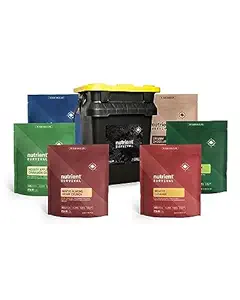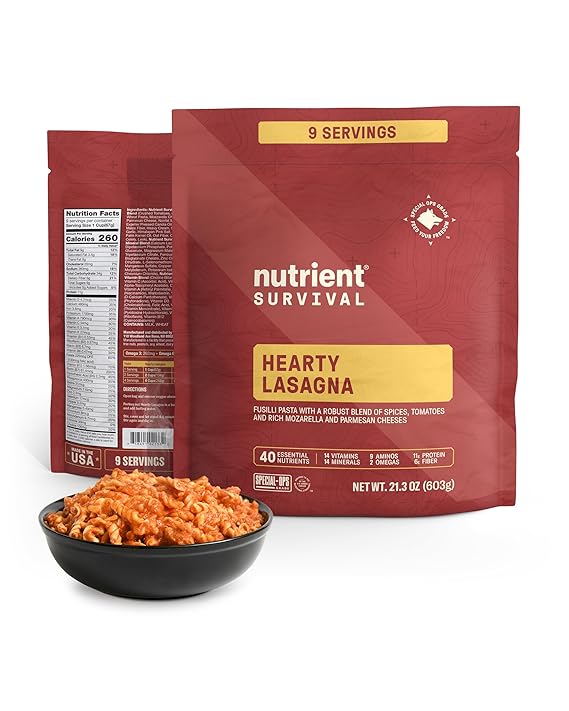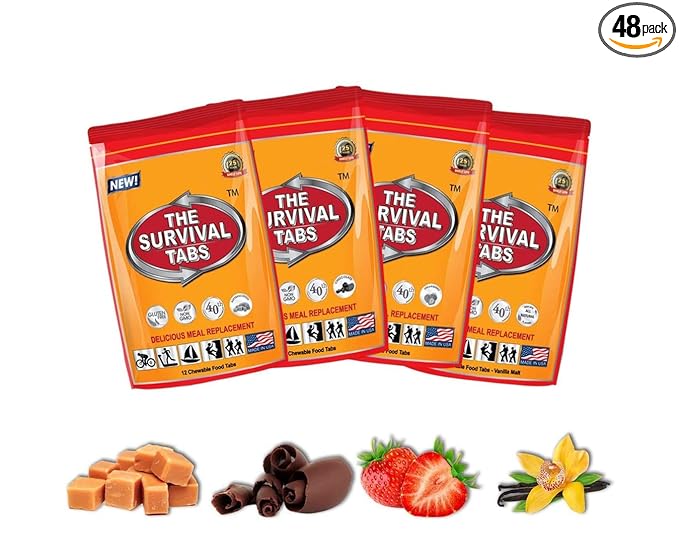I have a confession to make. I have wasted a fair amount of food, purchasing cans to provide for my family in times of need, and then letting them expire without using them. But in the process, I’ve discovered what works and what doesn’t for emergency food storage, what to store in my emergency backpacks, what to save in my pantry, and what to stockpile in my basement. I’ve built my perfect Prepper Food List to help you avoid the cost, wasted time, and frustration of having to waste good food that could have been used to nurture your family. I can help you avoid the traps, and move food preparedness from just another “should do”, to “I’ve taken care of this prep step and am one step closer to being the hero my family needs in an emergency”. By implementing my tiered Prepper Food List system, you’re going to gain a framework for thinking about your family’s disaster food plan, and you’ll know exactly what step to take next.
How to Acquire Emergency Food Supplies
Many beginning preppers have an unclear sense of priorities when it comes to building out their family’s emergency preps – it’s a lot to think about, and can be overwhelming. Buying extra of the foods your family already eats is a great, easy beginning choice for the middle-tier, (building up a 30 day emergency food supply) but these food storage options are not that great when it comes to mobility (tier 1) and long-term stockpiles. (tier 3) Cans are heavy, which makes them hard to carry, and they only last for a couple of years, which makes long-term storage tricky. So, in addition to having a few extra cans of chili or tuna, I recommend getting started with building your short-term 72-hour emergency kit first, then developing a well-stocked pantry (supplemented with garage storage if available) of up to 30 days, followed, finally, by a long-term food storage plan for even longer. This way you don’t have to jump into a $1000 pre-packed dehydrated emergency food solution, until you’re ready to move up to that level.
(Don’t get me wrong, if you have one of those wheeled trash cans full of emergency food already, that’s great! In no way do I want to diminish that achievement. I just want you to back up and make sure that you have your other needs met. I don’t think you want to be noisily dragging your survival food behind you during a forced evacuation or other Bug Out scenario, because you never prepared a Go Bag.)
This Prepper Food List is organized from “most urgent” to “least urgent” so that you can get started with a short time window of complete self-sufficiency and then extend that forward in time. That way, you’ll be prepped for short-term, more likely, disasters up front, as you’re investing your resources and incrementally building up to higher cost/more uncertain outcomes.
Tier 1: What to Carry With You
72 hours – Light, compact nutrition to keep you going with nothing else required
The goal for the first 72 hours is to stay lightweight, flexible, and mobile, without letting your hunger ruin your mood or affect your judgement. 3 days is the minimum prep time you have to have covered for any sort of emergency, especially if you need to evacuate. Your 72 hour food choice should go in a comfortable, well-made backpack, which is the first thing you grab if you have to bail out of your home.
The 72 hour Bug Out Bag food recommendation “Survival Tabs” are a good value for the nutrition you get and lightweight for staying mobile. These tablets will get you through a few days of being away from your pantry, or while relocating to a different bug out spot. Rather than just a pure calorie bar, these tablets, inspired by the US space program, are designed as a nutrition replacement, giving you 100% of the recommended daily allowance of several essential vitamins and minerals, instead of just keeping your daily calories up.
2 weeks – Light, compact nutrition with minimal preparation (dried or freeze dried, just add water)
After the first 3 days, we still prize maximum lightweight flexibility for food options. If you have had to stay away from home longer, you want the security of knowing you have delicious, nutritious options with you, without having to fight crowds of unprepared and desperate people trying to lay hands on supplies being provided by government emergency responders. These supplies should go in your secondary backpack, a medium to large (~40L is the sweet spot) hiking backpack.
These pouches by Nutrient Survival are “just add water” survival food, independently tested to outperform Special Operations survival rations, with tasty recipes that can be eaten cold or hot, with no cooking needed to reconstitute. This variety pack has a storage box of large pouches instead of cans, which makes packing them for travel easier. (if you don’t mind ditching the storage box) One box is a full food supple for one adult for two weeks.

Food Supply, 14-Day Survival Food
(72 Servings) Bucket Disaster Kit,
Freeze Dried Ready to Eat Meals in
Resealable Packs, Shelf Stable up to
15 Years
Tier 2: 30 days – Pump Up Your Pantry
Anything over 2 weeks, I consider too long to be thinking about staying mobile. Unless this is a true SHTF situation, relying on bushcraft and survival farming, you’re going to need to get back to your home base preparations, or make it to your secondary location (which you’ve pre-stocked, and hopefully has perennial crops and forage options) to start a new life as a homesteader. Whichever scenario, this is the place with storage, where supplies can be heavy, optimized for nutrition, flavor and convenience, and not long-term storage. Cans of meat, vegetables, and fruit, premade meals such as chilis and soups, boxes of pasta, jars of sauce. A full fridge of vegetables and dairy, and a freezer full of meat fall into this category as well. This also assumes you have the infrastructure in place to boil water and cook in the absence of municipal utilities.
This is the place most prepping guides start because it is easy to just slightly increase the normal restock amount of things you already purchase, until you’ve built up a pantry full of disaster food you would eat eventually anyway. It is a great way to dip your toe into getting your family prepared. However, I make the Bug-Out-Bag-ready, lightweight, mobile tier-1 food a first goal, because you probably already have a good week or more of random stuff in your pantry already. Yes, you might have to get creative, and eat that bag of chips with a cold can of kidney beans, but you already have some easy options.
Regardless, to get an idea of your goal, here is an example 30 day emergency food supply list, with example quantities based on what you would need to feed a family of 4 a menu of “pretty normal” basic American cuisine. It is a lot, but don’t let it overwhelm you. Adjust to taste, and figure out where you would be able to store this quantity of food. Start chipping away at the easy parts.
~30 daily servings of animal protein
10-15 steaks
10 packages of chicken thighs
20 pork chops
3 beef or pork roasts
10 cans of tuna
10 cans of chicken
4 packages of bacon
3 gallons of milk
~30 daily servings of vegetables
10 jars of pasta sauce
3 bags of salad greens
10 cans of green beans
10 cans of corn
5 freezer bags of green peas
5 freezer bags of broccoli florets
5 freezer packs of cut spinach
~30 daily servings of carbs
10 boxes of pasta
10 cans of beans (kidney beans, black beans, chickpeas, etc)
2 bags of rice
4 5lb bags of potatoes
3 boxes of cereal
Misc snacks and cooking aids
5 bags of dehydrated apple slices
3 bags of fancy mixed nuts
2 bottles of cooking oil
1 5lb box of salt
5-10 jars of favorite spices and herbs
Tier 3: 1 Year – What to (stock)Pile
Clear out a spot in the basement or garage, it’s time to get to the sexiest part of prepping: long-term food storage. Seriously, I think this is the part of prepping that really moves you from casual to serious. Once you start to acquire stockpiles of food and ammo, that’s when you can laugh with your friends about how far off the deep end you’ve gone. (while you’re secretly laughing AT your friends for not being ready)
Now, technically, in order to have 1 year of food storage, you could accumulate a year’s worth of the normal food your family eats. Most of the cans and jars you would purchase are marked as good for 2-5 years already, and many are still safe to eat for years afterward. (I definitely do NOT recommend keeping boxes of pasta or bags of rice/beans, though, since the store packaging is not suited for long term storage, and is mostly worthless against pests.) Canned food has the advantage of being cheap, easy to stock up on incrementally, and it’s straightforward to rotate aging supplies into your normal eating, not to mention the water content (which makes it heavy) means that’s less water that you have to use out of your emergency water storage supply.
However, there are two downsides which lead some people to prefer freeze-dried or dehydrated foods for long-term storage instead of cans – weight and shelf-life.
Cans are heavy, with water making up about 30% of the contents. This can make it difficult to carry/transport any significant amount of canned food. If you have to load up the car and get out of dodge, you’re going to make a bunch of trips, or wear yourself out carrying heavy loads. The average 40L hiking backpack can handle around 100 standard cans, but good luck carrying that many. At over 100 lbs, you will be carrying around an extra German Shepherd, which will get you approximately 30 days. (I guess it gets lighter as you go along though, huh?) Would you rather that, or for the same number of servings, carry 12-15 pounds of freeze dried? That being said, this tier of food storage is for stockpiling to get you through long stretches in one location, not carrying it around with you, but lighter foods still have some definite advantages.
The other advantage of freeze-dried foods is their long shelf life. While they have a higher up front cost, their long storage life means that you don’t have to rotate them out as quickly, and with one purchase you can enjoy the confidence and worry-free nature of having a long-term disaster food stockpile that you can send with your elementary-aged kids when they go off to college.
I still really like these Nutrient Survival freeze-dried products, but for longer term storage, I go with the 9-serving bulk packs instead of the single serving size.

to Eat Meals (9 Servings) Freeze Dried
Prepper Supplies & Emergency Food Supply,
40 Essential Nutritients, Shelf Stable Up to 15
Years, Pantry Pack
Don’t Wait for Doomsday to Test Your Preps
One last point to consider as you plan your next steps for your disaster food supplies: eat your preps. Before deciding on a long term option, buy one to try, to make sure you can see yourself eating it. In an emergency, you’ll eat anything you can get your hands on, but you’ll be glad that you made sure it’s something you actually like. Once you choose a product or several, and get them safely stored away, set a calendar appointment for a year to remind you to break your storage open and eat up some of your emergency supply again. This practice helps you check for any damage or infestation, remember what’s there and what’s next to acquire, and most importantly, reinforces your mindset that when the worst comes, you’re already prepared with healthy food to keep your family safe and well-provided-for.
Conclusion
Prepping is about keeping yourself and your family safe and healthy in a disaster, and with this Prepper Food list, you can now orient yourself to where you fall on the Emergency Food Supplies preparedness spectrum, set a few critical priorities, and decide on your next step. You’ll avoid wasting good food by stashing things away and forgetting you have them, and you’ll save time and money by avoiding buying things you don’t actually want. Most importantly, you’ll be ready to take charge of your family’s disaster food prep, and become the hero they’ll thank when the SHTF.




